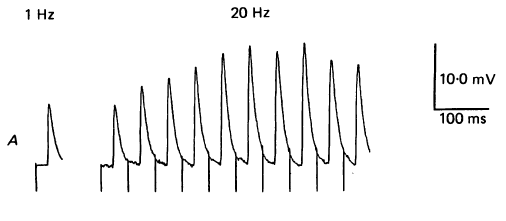
Burst-patterned stimulation promotes nicotinic transmission in isolated perfused rat sympathetic ganglia
Birks, R.I, Isacoff, E.Y. 1988, The Journal of Physiology
Abstract
- Intracellular recordings of small nicotinic excitatory postsynaptic potentials (EPSPs) were made from rostral cells in superior cervical ganglia (SCG) of rats during and after test stimulation of small preganglionic fibre bundles, while perfusing the isolated ganglia via their arterial vasculature. Perfusion, in contrast to superfusion of desheathed ganglia, (a) produced much more rapid and complete equilibration of drugs and ions at synaptic sites, (b) greatly reduced depression of EPSPs during high‐frequency stimulation, and (c) largely prevented slowing of conduction, presumably by minimizing accumulation of K+ in the intercellular spaces surrounding these sites. 2. Preganglionic inputs were found to fall into two major groups: those in which the EPSP amplitude during 200 pulse trains was facilitated and others in which it was depressed as stimulation frequency in the train was increased from 2 to 20 Hz or from 0.2 to 1.25 Hz. Both the facilitation and the depression were presynaptic, since they occurred without changes in miniature EPSP amplitude. 3. The maximum maintained facilitation was reached at 5‐10 Hz with a value 1.26 times the 1.0 Hz control. This was associated with an increase in the binomial parameter n. While long 20 Hz trains produced a similar facilitation to an early plateau, and an increase in n, EPSP amplitude declined as the train progressed. This was associated with a decrease in the binomial parameter p. 4. Unlike the 20 Hz trains, stimulation with 0.5 s long, 20 Hz bursts given every 8 s produced a marked potentiation in facilitating units and this was maintained for as long as the stimulation was continued (3‐11 min). Burst‐patterned potentiation was 1.66 times larger than the facilitation evoked by tonic stimulation at the same average frequency (1.25 Hz), and more than twice that achieved with long, 200 pulse trains. The potentiation was associated with increases in both n and p in the first EPSP of the burst and mainly with an increase in n at the end of the burst. Potentiation persisted unchanged for about 30 s following the return to control 0.2 Hz stimulation, before declining to control levels over the next 2‐3 min. Depressing units on average showed neither burst‐patterned potentiation nor post‐burst‐patterned potentiation. 5. All inputs tested in Locke solution in which Ca2+ was reduced to 0.5 mM with addition of 1.2 mM‐Mn2+ or 3.8 mM‐MgCl2 exhibited a pronounced facilitation within each burst but no extension of potentiation into ensuing bursts. Both burst‐patterned potentiation and the post‐burst‐patterned potentiation were abolished.